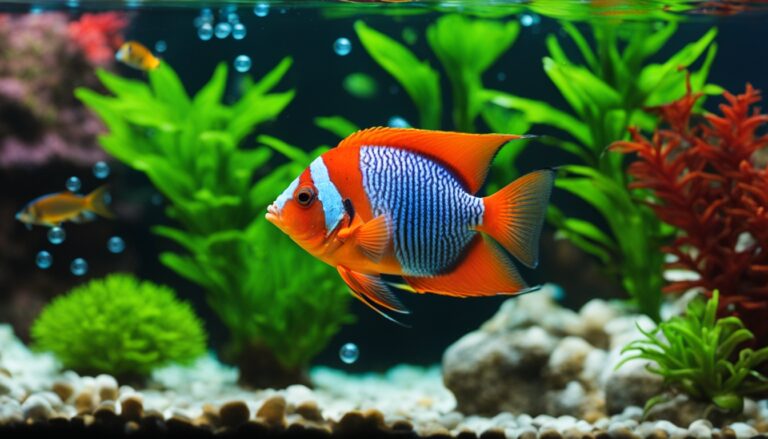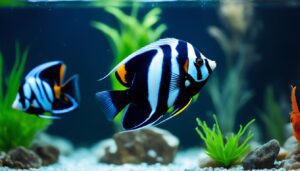Welcome to the vibrant world of marine fish keeping. Here, the flame angelfish is a prized jewel among fish lovers. It’s thrilling to watch these bright fish move in my aquarium. Their care is a mix of the right environment, friends, and food.
For living with other fish, there’s a rule: a 65-gallon tank is a must for an adult flame angelfish, also known as Centropyge loriculus. These fish, with their sleek 4-inch bodies, move gracefully. Yet, they can be a bit naughty with soft corals, so they’re considered “reef safe with caution.”
I’ve noticed something interesting as a fish enthusiast. With the cost of wild flame angelfish going up, there’s more interest in breeding them. This makes the fish even more desirable.
Keeping a group of flame angelfish shows the true beauty of fish keeping. These fish can change from female to male, showcasing the wonders of marine life.
After years in this hobby, I have some advice. Add flame angelfish to your tank last to keep the peace. Don’t worry about what they eat. A diet of sponge and algae is perfect for them. Taking care of them is like creating a piece of underwater paradise. It’s a rewarding challenge.
Flame Angelfish Species Profile

The dwarf flame angelfish is a bright gem in Indo-Pacific marine life. It catches eyes with its bold colors and active nature. Let’s explore this species’ home, habits, and why it’s loved in aquariums.
Natural Habitat and Origin
The dwarf flame angelfish calls the vast coral reefs of the Indo-Pacific home. These reefs, full of hiding spots, offer safety and food, like algae and small invertebrates.
Coloration and Patterns
The flame angelfish’s looks are stunning. It’s draped in red and orange with black stripes and blue-tipped fins. Its bright colors make it a highlight in tanks, reflecting the lively coral reefs it comes from.
Behavioral Traits and Compatibility
This angelfish is known for being lively and bold in a tank. Though usually peaceful, they can get territorial with similar fish. Their compatibility with others depends on their own nature and the tank setting.
The dwarf flame angelfish isn’t just pretty; it’s fascinating too. Its bright look and lively ways make it a favorite in Indo-Pacific marine life. Here’s more about caring for these captivating fish:
Characteristic |
Detail |
|---|---|
Scientific Name |
Centropyge loricula |
Average Lifespan |
5 to 7 years |
Diet |
Omnivorous – prefers algae and invertebrates |
Habitat |
Coral reefs in Indo-Pacific region |
Behavior |
Active, territorial with species of similar appearance |
Reproduction |
Spawning occurs at dusk; female releases eggs in water column |
If you’re into fish or just starting to explore marine life, the dwarf flame angelfish is a treat. It offers beauty and a peek into coral reef life.
The Needs of Your Flame Angelfish
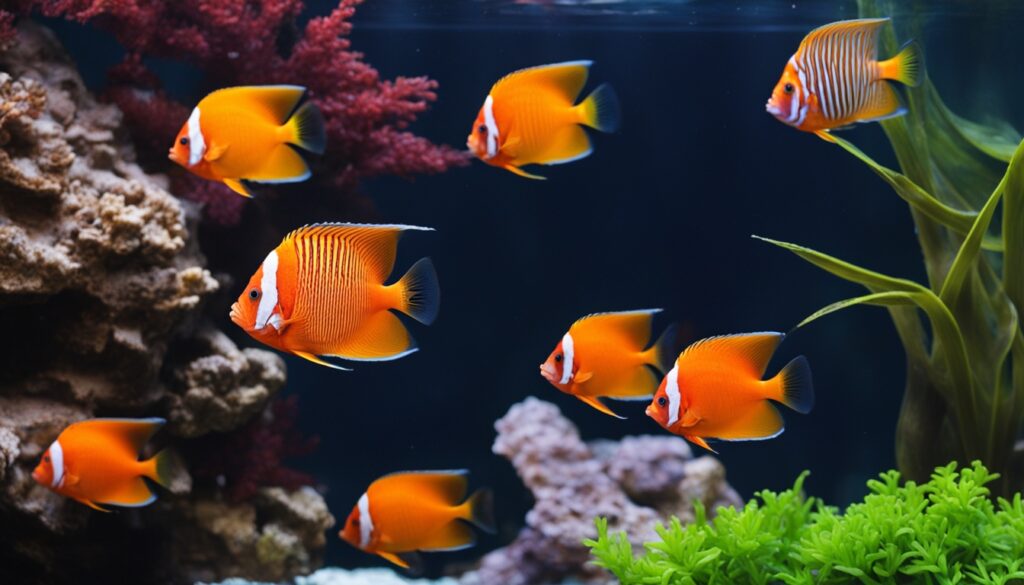
Looking after a flame angelfish means knowing a lot about them and how to take care of saltwater fish. Keeping their home just right is key to having a bright, healthy fish. I’ll talk about what they need, focusing on aquarium maintenance to make their space perfect.
First off, keeping the water quality high is essential. The right conditions include a pH level between 8.1 and 8.4. Salinity should be from 1.023 to 1.025, and temperatures between 72°F to 78°F. These settings make their tank feel like their natural ocean home, which is very important for their health.
- Make sure the tank is big—flame angelfish do well in tanks of at least 70 gallons. This gives them plenty of room to swim and claim their space.
- It’s important to keep an eye on copper levels, as these fish are highly sensitive to copper. Keep it below 0.15ppm to keep them safe.
- Their diet should include a variety, like algae, Nori, Spirulina, Mysis shrimp, and quality marine flakes and frozen foods. This helps meet their dietary needs.
When it comes to living with others, flame angelfish are kind of pushy but can live with other angelfish if the tank is big enough. Pay close attention to how they get along with other reef dwellers. This helps avoid trouble with corals and certain invertebrates, especially if they’re hungry or the tank’s too full.
While these angelfish can adjust to different settings, they’re quite sensitive when first moved to a new tank. It’s a good idea to keep them in a separate tank at first. Then, slowly get them used to the main tank. This helps them settle in without stress or health problems.
Following these key flame angelfish requirements, from consistent aquarium maintenance to proper saltwater fish care, ensures your flame angelfish will thrive. Your commitment to meeting their needs and making it part of your routine will bring you joy as they live a vibrant, long life.
Creating a Flame-Angelfish-Friendly Tank Environment
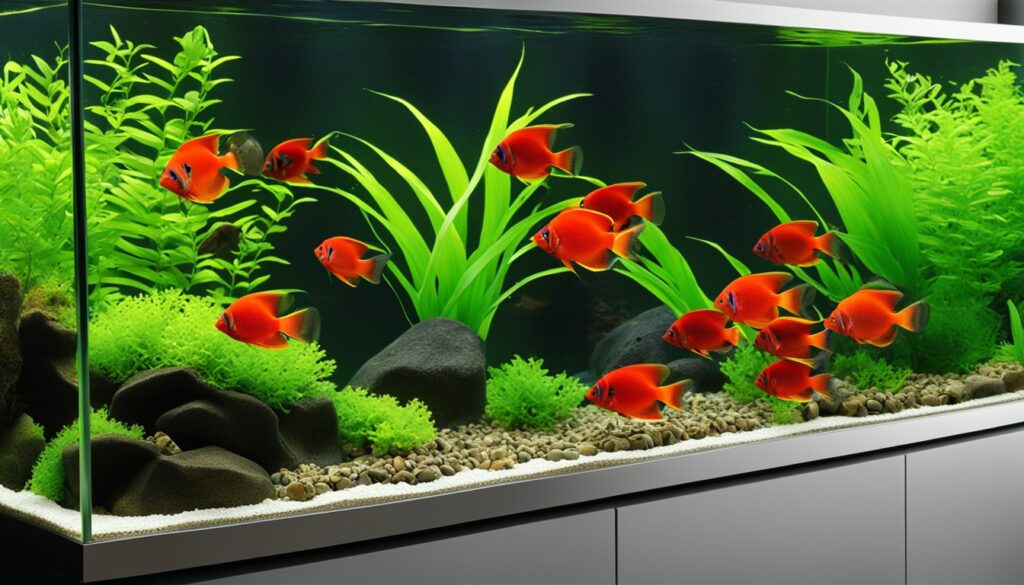
Welcome to creating the perfect home for your Flame Angelfish. I’ll help you with the ideal aquarium setup. We’ll ensure the marine water conditions are just right for your fish to flourish.
Tank Size Requirements and Aquascaping
A single Flame Angelfish needs at least 55 gallons of space. For a community, a bigger tank is better. This space lets them swim and explore, which they love. In aquascaping for flame angelfish, create a home-like environment. Use rocks and corals to give them places to hide and feel safe.
Here’s what you need to know:
- Adequate tank size: At least 55 gallons for one; 150 gallons for several.
- Optimal Aquascaping: Include live rocks and caves for less stress.
Water Parameters: pH, Salinity, and Temperature
Keeping water conditions stable is key for Flame Angelfish health. They thrive in pH levels of 8.1 to 8.4. The water’s specific gravity should be between 1.020 and 1.025. Keep the temperature soothing between 72°F and 78°F, close to their ocean home.
Parameter |
Value |
|---|---|
Temperature |
72-78°F |
pH |
8.1-8.4 |
Specific Gravity |
1.020-1.025 |
Check the marine water conditions often. This keeps your aquarium perfect for your Flame Angelfish.
Adding Live Rock and Hiding Places
Live rock makes your tank look great and gives fish hiding spots. These spots are vital for the Flame Angelfish’s well-being. They mimic the natural reef, offering retreats to lower stress.
Adding different shapes and levels in your tank makes it look nicer. Plus, it gives your Flame Angelfish the hiding spots they need.
Remember, keeping everything consistent is crucial. From aquarium setup to aquascaping, and managing water conditions well. Follow these steps for a happy, healthy environment for your Flame Angelfish that reflects their natural marine world.
A Balanced Diet for a Healthy Flame Angelfish
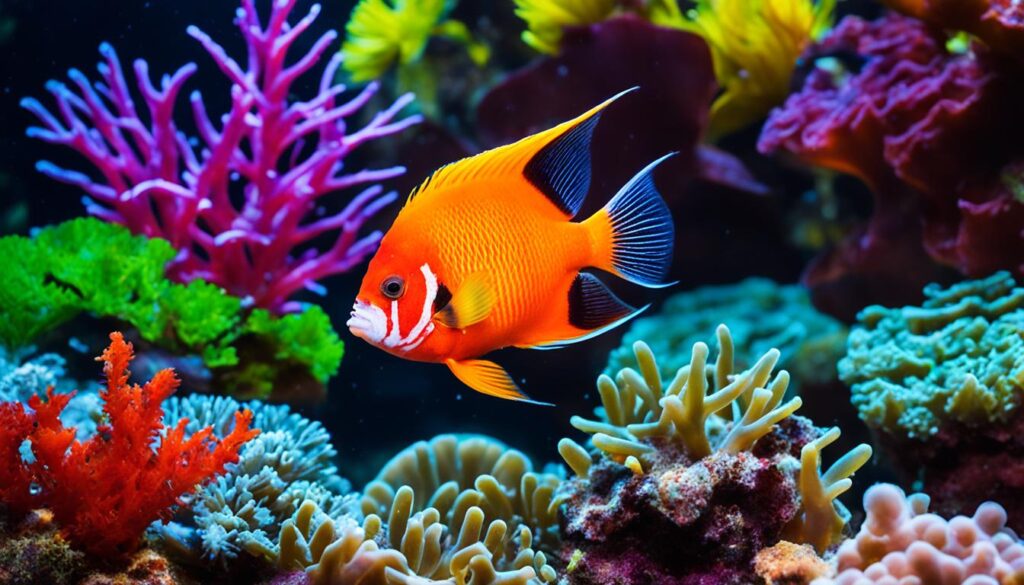
To keep a Flame Angelfish healthy, it’s crucial to know what it eats. As a marine omnivore, it needs a mix of foods. The right diet keeps their colors bright and their health strong. We’ll look at what they should eat, how often, and important supplements.
Omnivore Requirements
Flame angelfish eat both plants and meat. It’s good to feed them a variety of foods. This includes quality flakes, pellets, and live foods like mysis shrimp. Adding seaweed and spirulina is also important for their health.
Feeding Schedule: How Often to Feed Your Flame Angelfish
Feeding your angelfish two to three times a day is best. This keeps them healthy by mimicking their natural feeding in the wild. Small meals are better. Remember to remove leftovers to keep the water clean and avoid overfeeding.
Supplements and Vitamins for Enhanced Coloration
Flame Angelfish do well with extra vitamins in their diet. Supplements like Vita-chem and garlic help their immune system and brighten their colors. Using these regularly will keep your fish looking vivid and healthy.
The table below shows how different foods and supplements affect your angelfish:
Factor |
Dietary Content |
Benefits |
|---|---|---|
Protein sources |
Mysis, live brine shrimp |
Boosts growth and health |
Vegetable sources |
Spirulina, seaweed |
Aids in digestion and mimics natural diet |
Supplements |
Vita-chem, garlic extract |
Enhances coloration and immune system |
Flame Angelfish: Breeding Practices and Tank Mate Selection
I’ve loved flame angelfish because of their amazing colors. But, breeding flame angelfish is not easy. These fascinating creatures can change their gender, often in just 60 days. To breed them, you must mimic their real-world home. You can start with a pair or two females and wait for one to become male. For those deeply into marine fish propagation, this is a rewarding challenge.
It’s crucial to have a peaceful tank. Picking the right choosing compatible tank mates is key for your flame angelfish. Calm fish like royal grammars and yellowtail damsels are good choices. Cleaner shrimps and six-line wrasses won’t bother them either. Add a flame angelfish last to prevent fighting. Always get your fish from reliable sources who care about the ocean.
Maintaining peace in the tank is essential, especially with flame angelfish. Once, my fish Sparks stopped using one fin, likely due to a fight. These fish need clean water and the right food, like microalgae. It takes effort and understanding to keep a balanced tank. But with careful attention, flame angelfish are a stunning addition to any aquarium.
